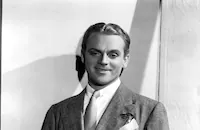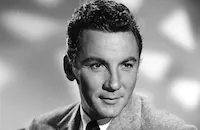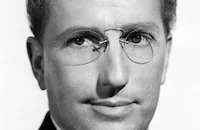Love Me or Leave Me

Brief Synopsis
Cast & Crew
Charles Vidor
Doris Day
James Cagney
Cameron Mitchell
Robert Keith
Tom Tully
Film Details
Technical Specs

Synopsis
At a Chicago dance club in the 1920s, small-time Jewish gangster Martin Snyder is collecting money for his laundry service and protection racket when an altercation breaks out over a taxi dancer, Ruth Etting, who has kicked a customer for getting fresh. Ruth is fired, and Marty--who is known as "The Gimp" because he walks with a limp--offers to help with her show business aspirations by using his many nightclub connections. Marty's business card gets Ruth a job as a chorus dancer at a fancy nightclub, where she meets handsome pianist Johnny Alderman. Eager to reap his reward for helping her, Marty tells Ruth she is going to Miami with him, but when she angrily refuses to be his mistress, he relents. Although he has no idea if Ruth can even sing, Marty hires Johnny as her coach and arranger, and Ruth turns out to have great natural talent. Johnny warns her that Marty's intentions are not honorable, but Ruth maintains that she needs him to advance her career. Marty arranges for Ruth to replace the headliner at the club, and her debut is a great success. Marty fills Ruth's dressing room with flowers and tells her after the show that they will celebrate at a weekend house party in the country. Ruth demurs, saying she is too tired to go out, but Marty informs her that their relationship has changed. As they quarrel, Ruth smoothly manipulates Marty, who has fallen in love with her, and he cancels the weekend plans.
One night after a show, Ruth introduces Marty to New York agent Bernard V. Loomis, who says he has lined up a booking for her. Marty jealously dismisses Loomis, telling Ruth that he has other plans for her. Marty then tells his right-hand man Georgie that he wants to get Ruth radio exposure, and she soon has her own radio program, with Johnny conducting the orchestra. Now in love with Ruth himself, Johnny advises her to end her relationship with Marty and let Loomis represent her, but she refuses. As Ruth's popularity grows, Marty contacts Loomis and arranges Ruth's New York debut as the star of the Ziegfeld Follies. Johnny tells Marty he will not accompany them to New York, and the men argue bitterly over Ruth. During rehearsals, Marty is outraged when Ziegfeld's staff does not treat him with the respect he is accustomed to commanding in Chicago. Loomis counsels him to keep a lower profile, to avoid damaging Ruth's chances, and Marty tries to rein himself in. However, Marty insists on seeing Ruth after her first number on opening night, and when he finds he is not welcome backstage, becomes violent. Angry and humiliated, Marty wants to break Ruth's contract, but she refuses to leave the show. When Ruth tearfully explains that his crass behavior does not fit in with her new life, Marty reproaches her for not standing by him. Although she does not love Marty, Ruth marries him out of a sense of obligation and quits the Follies. Ruth's career continues to flourish under Marty's management, and she sells out nightclub appearances all over the East Coast as Marty works tirelessly on her behalf.
One night, Marty tells Ruth he has made a movie deal for her, but the embittered Ruth, who has taken to drinking, responds indifferently. She brightens when she receives a phone call from Johnny, who now works in Hollywood and says he will be working on the film with her. In Hollywood, Marty and Loomis meet with producer Paul Hunter, and Marty is shocked to discover that Johnny is the music director on the picture. Afterward, Marty derides Johnny to Loomis as a phony, and Ruth snaps that Marty has accomplished nothing on his own. Stung by Ruth's words, Marty sells his laundry in Chicago and invests all his money in a nightclub that he wants to remodel. Later, Marty secretly comes to the studio and watches a recording session, and fumes when he notices the silent connection between Ruth and Johnny. Marty tries to have Johnny fired from the picture, and orders Ruth to quit the film and work in his club. When Ruth accuses him of being afraid of losing his grip on her, Marty loses his temper and strikes her. Ruth flees, and the next day arranges a meeting in Loomis' office, where she tearfully begs Marty for a divorce. Although Marty declares that Ruth will come running back to him, he is crushed by the rejection and can think of nothing else, even with his club about to open.
Several nights later, Johnny follows Ruth home and kisses her, and as he returns to his car, Marty shoots him. At the hospital, Ruth declares her love for Johnny, then tells Loomis that she feels bad about the way she left Marty. She visits Marty in jail and says she plans to marry Johnny, then tries to thank him for all he has done, but Marty bitterly refuses to listen. Loomis bails Marty out of jail, and Georgie takes him to the club, where Marty is shocked to see a neon sign announcing Ruth's appearance. Marty flies into a rage at the "handout," but Loomis insists that he be big enough to allow Ruth to repay him. Due to the publicity generated by the shooting, the club is swarming with autograph-seekers and press, and as Marty escorts the reporters through his elegant establishment, his old confidence begins to return. When asked about Ruth's appearance at the club, Marty replies that it is strictly a business arrangement, adding that he has great respect for Ruth as an artist. As the floor show begins, Marty watches with pride and satisfaction as Ruth sings before the appreciative audience.

Director

Charles Vidor
Cast

Doris Day

James Cagney

Cameron Mitchell

Robert Keith

Tom Tully

Harry Bellaver

Richard Gaines

Peter Leeds
Claude Stroud
Audrey Young
John Harding
Henry Kulky
Otto Reichow
Jay Adler
Mauritz Hugo

Veda Ann Borg
Claire Carleton
Larri Thomas
Patti Nestor
Winona Smith
Shirley Wilson
Benny Burt

Robert Carson
James Drury
Michael Kostrick
Robert Malcolm
Robert Stephenson
Richard Simmons
Paul Mcguire
Barry Regan
Roy Engel
John Damler
Wally Walker
Herbert Winters
John Alban
Dick Cherney
Mal Alberts
Jimmy Cross
Henry Randolph
Chet Brandenberg
Joe Pasternak
Bob Stevens
Max Smith
Bill Lee
Thurl Ravenscroft
Genevieve Aumont
Crew
Irving Aaronson
Fred E. Ahlert
Arthur E. Arling
Irving Berlin
Rube Bloom
Nicholas Brodszky
Lew Brown
Sammy Cahn
Ridgeway Callow
B. G. Desylva
Walter Donaldson
William Dorfman
Alvord Eiseman
Percy Faith
Don Flick
Daniel Fuchs
Daniel Fuchs
Cedric Gibbons
Johnny Greenwald
Sydney Guilaroff
Darrell Hallenbeck
Lorenz Hart
Ray Henderson
Gus Kahn
Ted Koehler
Isobel Lennart
Joe Mccarthy
Urie Mccleary
Wesley C. Miller
James V. Monaco
Jack D. Moore
Warren Newcombe
Jack Palmer
Joe Pasternak
Chilton Price
Art Pullen
Richard Rodgers
Alex Romero
Helen Rose
Sid Sidman
George Stoll
Roy Turk
William Tuttle
Stewart Walden
Spencer Williams
Edwin B. Willis
Ralph E. Winters

Photo Collections
Videos
Movie Clip




Trailer
Hosted Intro
Film Details
Technical Specs

Award Wins
Best Story
Award Nominations
Best Actor
Best Score
Best Screenplay
Best Song
Best Sound
Articles
Love Me or Leave Me
The film was also a departure from Doris Day's previous films for Warner Brothers where she was usually cast as the cheerful, pretty girl-next-door. As Ruth Etting, Day had one of the most challenging roles of her career and risked alienating her many fans with the hard-edged subject matter. In fact, in the biography, Doris Day: Her Own Story by A.E. Hotchner (William Morrow & Co.), Day describes a powerful scene with Cagney that was trimmed by the censors: " He attacks me savagely; and the way Cagney played it, believe me, it was savage. He slammed me against the wall, ripped off my dress, my beads flying, and after a tempestuous struggle, in which I tried to fight him off with every realistic ounce of strength I had, he threw me on the bed and raped me. It was a scene that took a lot out of me but it was one of the most fully realized physical scenes I have ever played...it wasn't until I saw the movie in its release that I became aware that most of the scene had been cut. I was told that it couldn't get. "
Love Me or Leave Me was an unqualified success and earned six Oscar® nominations including a third Best Actor nod for James Cagney. It might have turned out differently if the director had been George Cukor with the Etting role played by Ava Gardner, both of whom were originally considered for the film. One person who wished it HAD turned out differently was Ruth Etting, who reportedly said, "I never at any time was a dancehall girl. It was just a means of working in "Ten Cents a Dance;" They took a lot of liberties with my life but I guess they usually do that kind of thing."
A final irony about Love Me or Leave Me is the fact that the relationship between Ruth Etting and Marty Snyder had some disturbing parallels to the relationship between Doris Day and her husband Marty Melcher. Like Snyder, Melcher also controlled Day's business affairs, made creative decisions for her even though he had no musical experience, and lived through her work. When Melcher died in 1968, Day discovered that he had mismanaged her entire life savings of $20 million dollars, leaving her completely broke.
Director: Charles Vidor
Producer: Joe Pasternak
Screenplay: Daniel Fuchs, Isobel Lennart
Cinematography: Arthur E. Arling
Editor: Ralph E. Winters
Music: Nicholas Brodszky, Percy Faith, George E. Stoll
Art Direction: Cedric Gibbons, Urie McCleary
Cast: Doris Day (Ruth Etting), James Cagney (Martin Snyder), Cameron Mitchell (Johnny Alderman), Robert Keith (Bernard V. Loomis), Tom Tully (Frobisher).
C-123m. Letterboxed. Closed captioning.
by Roger Fristoe

Love Me or Leave Me
Quotes
Trivia
It was James Cagney who suggested to producer Joe Pasternak to cast 'Day, Doris' in the role of Ruth Etting. They had worked together previously in West Point Story, The (1950).
According to an interview with Ruth Etting, she never actually worked as a dance hall hostess. This was dramatic fiction, to underscore the song "Ten Cents a Dance".
This was the only time, after becoming a star in the 1930s, that James Cagney ever accepted second billing for a major role. He thought that Doris Day's character was more central to the film's plot, and so ceded top billing to her.
The character James Cagney played, Martin Snyder also known as the Gimp was portrayed in the film as a small time hood. Ironically he ended up working in the license department in Chicago's City Hall.
Notes
The working titles of the film were Singin' the Blues and The Ruth Etting Story. The opening credits identify the two new songs written for the film, "I'll Never Stop Loving You" and "Never Look Back," then introduce the composers of the standards performed in the film as follows: "...And some of the old songs which will be associated always with the name of Ruth Etting-great songs by our greatest song writers, among whom are: Irving Berlin-DeSylva, Brown & Henderson-Walter Donaldson-Arthur Freed-Gus Kahn-McCarthy & Monaco-Rodgers & Hart-Turk and Ahlert." Brief snippets of the songs "What Can I Say After I Say I'm Sorry," "I Cried for You" and "My Blue Heaven" are heard in a montage sequence depicting the rise of Etting's recording career.
Ruth Etting (1896-1978) married Moe "The Gimp" Snyder in 1920. She starred in the Ziegfeld Follies from 1927-31, performed on Broadway in shows such as the popular 1928 musical comedy Whoopee, in which she introduced the song "Love Me or Leave Me," and appeared in the M-G-M films Roman Scandals and A Gift of Gab (see AFI Catalog of Feature Films, 1931-40). Etting was also a popular radio performer in the 1930s and a highly successful recording artist. She married her pianist, Myrl Alderman [called Johnny Alderman in the film], in 1938, after Snyder shot him in a fit of jealousy. Etting and Alderman remained married until his death in 1966. A number of reviews pointed out that Etting, Snyder and Alderman were still alive when the film was made, and that all three received undisclosed payments from M-G-M for the rights to portray them onscreen.
A September 1953 Daily Variety news item reported that Jane Powell would portray Etting, and an October 1953 item in Hollywood Reporter's "Rambling Reporter" column suggested that M-G-M was testing Jane Morgan for the role. According to Hollywood Reporter news items, Ava Gardner was cast as Etting in April 1954, and was placed on suspension when she refused the role. In her autobiography, Gardner wrote that she turned down the assignment because she was "afraid it would be just another fairly standard biography." A modern source claims that George Cukor originally selected to direct the film. According to May 1954 items in Hollywood Reporter's "Rambling Reporter" column, Humphrey Bogart and Richard Widmark were considered for the role of Snyder, and October 1954 columns reported that Farley Granger had tested for the film, and that Fred Clark was under consideration for a role. A September 1954 Hollywood Reporter news item adds Keenan Wynn to the cast, but he was not in the film. Hollywood Reporter news items and production charts also include Benny Rubin, Stephen Bekassy, Robert Dix, Cosmo Sardo, Johnny Olszewski and singer Chris Warfield in the cast, but their appearance in the final film has not been confirmed. Although an October 1954 Hollywood Reporter news item named Joseph Ruttenberg as the film's director of photography, Arthur E. Arling was credited onscreen. Cameron Mitchell, who portrayed Alderman, was borrowed from Twentieth Century-Fox for the production.
Modern sources assert that Etting was not pleased with the final film, and considered it a distortion of her life. According to an internal memo in the file on the film in the MPAA/PCA Collection at the AMPAS Library, Etting refused to approve an August 1954 draft of the script because it made it appear that she and Snyder were having an affair early in her career, when in fact they were married at the time. "Since Miss Etting insisted that the script be altered accordingly," the memo stated, "This presented the Code problem of the breakup of her marriage to The Gimp and the suggestion that she eventually marries her piano player." The memo noted that the Code's ban on divorce might be circumvented because Etting's marriage was not ended for "romantic reasons" (so that she could marry someone else), but because of Snyder's vicious nature. On October 6, 1954, Daily Variety editor Joe Schoenfeld's "Time and Place" column revealed the behind-the-scenes conflict, adding that Etting and Snyder had "[threatened] to sue Metro if it portrayed them not married, which would be tantamount to telling the world that they had lived together in sin. Now the company is caught between the Code and the threat of a lawsuit, but with still no solution to the crux of the drama."
Correspondence in the PCA file indicates that PCA director Joseph I. Breen wrote to Schoenfeld the following day, denying the version of events presented in the column. Schoenfeld wrote back on 11 Oct, claiming to have gotten his information from a "reliable source" and stating, "If the facts as I wrote them...are incorrect as pertaining to your office, then some of the people associated with this picture at Metro are sadly misinformed." According to a March 1957 Daily Variety news item, Etting brought a one million dollar libel suit against the Hearst Corporation, publisher of Cosmopolitan, claiming that she was maligned by an article in the April 1956 issue about Doris Day's performance in Love Me or Leave Me. In her suit, Etting cited the article's description of her as "a famous girl singer of the twenties who fell in love with a bad man, became an alcoholic, and inspired a murder." The outcome of the suit has not been determined.
Love Me or Leave Me received the Academy Award for Best Motion Picture Story, and was nominated in the following categories: Best Actor (Cagney), Best Screenplay, Best Sound Recording, Best Song ("I'll Never Stop Loving You") and Best Scoring of a Musical Picture. Love Me or Leave Me was the first M-G-M film for Day and Cagney, and marked arranger Percy Faith's first screen assignment. The film also marked the first time Cagney was not given top billing since A Midsummer Night's Dream in 1935. Day and Cagney had earlier co-starred, along with Gordon McRae, in the 1950 Warner Bros. musical The West Point Story (see AFI Catalog of Feature Films, 1941-50). A modern source adds Dorothy Abbott (Dancer) and Phil Schumacher (IBouncer ) to the cast.

Miscellaneous Notes
Winner of the Writers Guild of America Award for Best-Written American Musical of 1955.
Released in United States Summer June 1955
Released in United States on Video August 1988
Released in United States December 1990
Shown at Laemmle's Monica in the series "MGM Musical Festival" in Los Angeles December 14-20, 1990.
CinemaScope
Released in USA on laserdisc February 1989.
Released in United States Summer June 1955
Released in United States on Video August 1988
Released in United States December 1990 (Shown at Laemmle's Monica in the series "MGM Musical Festival" in Los Angeles December 14-20, 1990.)
















